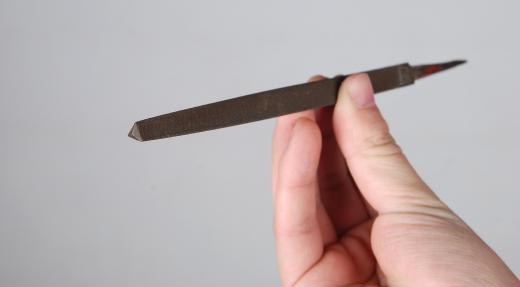A square file is a metal tool with a rough surface used to remove small amounts of wood or metal from a workpiece. Ranging from six to 18 inches (15 – 46 cm) long, more or less, they generally have a narrow, pointed tang at one end designed for insertion into a removable handle. Square files are wider at their base, but rarely more than an inch (2.54 cm) or so, and taper to a narrow tip.
One of the most basic of hand tools, rasps have been found in archaeological digs dating as far back as 1200 – 1000 BC. The older rasps were made of brass, and more recent rasps were made of iron. Modern files are made of hardened steel with series of parallel ridges cut into them, or with industrial diamonds embedded in their surface.

Modern files have either one set of ridges or two cut at angles to each other. A file is called single-cut when only one set of such ridges has been cut; a double-cut or diamond-cut file has two sets of ridges, forming diamond-shaped teeth. The more ridges per inch, the finer the cut. From smoothest to roughest, the six generally recognized grades of file roughness are dead smooth, smooth, second-cut, bastard, middle, and rough. All four sides of a square file will have teeth cut into them, although some files of other shapes are left with some smooth surfaces so that the teeth can be used right to the edge of an inside corner without damaging the adjoining side.
A square file cuts on the push stroke; the craftsman holds the handle in one hand and places the palm of the other hand on the forward portion of the file and pushes the file forward on the part of the workpiece from which stock needs to be removed. The best work is done when both hands are used to exert a consistent pressure, as well as control the file. Using one hand alone will result not only in an uneven cut, but there's a better chance that the file will deviate from the intended work area. When stock must be removed from a large workpiece, many craftsmen will make diagonal cuts to cover more area and produce a more even surface.
When a square file is used to clean out a right-angle interior cut, such as a woodworking mortise, it's sometimes not possible to provide pressure and guidance on the forward end of the file. When this is the case, the work generally is done more slowly to avoid deviations in the cut and to ensure as consistent pressure as possible.
A square file is only one of many that woodworkers and metalworkers will have in their toolboxes. Other popular files are mill files, round files, and three-square files, which are actually triangular. Many files are very small, sometimes no more than one-fourth of an inch (6.35 mm) wide at their widest point. These smaller files, often called needle files, usually replicate the shape of their larger counterparts, and a set of miniature files will often include a square file, a round file, a three-square file, among others. Needle files are very useful for detail work in both wood and metal, as well as for deburring metalwork.
